Robert A. Heinlein: The Juvenile Novels
Reviewed by Galen Strickland
Posted July 27, 2000, with later edits
Following World War 2, RAH moved to Colorado Springs with several projects in mind. One was the design and construction of a new home, for which he knew it would be necessary to obtain higher pay-rates for his work. He set out to write several stories with the "slick" publication of The Saturday Evening Post in mind. The Post was at that time the highest-paying fiction market in the U.S., as well as one with a very high circulation. He was fortunate to have obtained as his agent Lurton Blassingame, who had many connections with the slick markets, as well as a brother who had been a regular contributor to the Post.
A purchase through our links may earn us a commission.
"The Green Hills of Earth" was the first of four RAH stories accepted by the Post, and others followed in Argosy, Blue Book, and Town and Country, as well as the specialty publications Boy's Life and the American Legion Magazine. At the same time he had been approached by a publishing house anxious to create a series of science fiction juveniles for boys. Although this initial deal did not come to fruition, Blassingame was successful in generating interest in the idea with an even more reputable firm. In 1947, Rocket Ship Galileo, the first of twelve annual entries in this series, was published by Charles Scribner's Sons. Some sources list a thirteenth title, 1963's Podkayne of Mars, as being part of this juvenile series, but I would not, the reasons for which I will explain later.
The book cover images that follow are certainly not the current editions available if you take our links to amazon.com. Even though they are not the ones I have at this time, to the best of my recollection they are the first editions I read, most of them the ACE paperbacks issued in the mid-60s. Some of them may have still been in print with these covers several years later as I discovered them, or else I found them in various used bookstores around town. The only one represented that I have never personally seen is the cover of the 1959 Magazine of Fantasy & Science Fiction featuring the serialized version of "Starship Soldier." I was only nine years old at that time, plus I didn't get started on my SF explorations for nearly ten years after that.
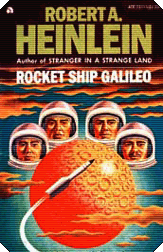 |
With only a couple of exceptions, it is unfortunate that these titles are still referred to as "the juveniles." Although the main protagonists are adolescents to late teens, most of the plots are as sophisticated as any SF written up to that time - and quite a bit since, too - and can be enjoyed by readers of all ages. They are all coming-of-age tales, with heroes and heroines who are for the most part more intelligent and resourceful than the adults they encounter. Even though the market for the pulps where RAH built his reputation was for the most part younger readers, his intended target for all of his work had up to this time been a maturer audience.
His first juvenile suffers the consequence of his attempt to condescend to the level of a teenage audience, as well as the constraints in content dictated by the publisher. The title of his first effort was at least better than his original working title (Young Atomic Engineers) but the result was not much improvement. The tale fosters the highly improbable notion that three rocket-obsessed teenagers, with the aid of one's nuclear physicist uncle, could not only build a rocket capable of reaching the moon, but actually accomplish the task as well. Rocket Ship Galileo has always been credited as being the basis of the classic SF movie Destination Moon of 1950, for which RAH wrote the screenplay and served as technical adviser. I have always been of the opinion that the movies' story more closely resembles that of the novella "The Man Who Sold the Moon," originally published in 1950. One aspect of the juvenile novel that thankfully did not appear in the film is the discovery of a Nazi outpost on the moon, although that was not so far-fetched an idea at the time considering the Germans' advancements in rocketry.
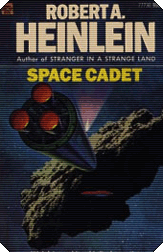 |
A purchase through our links may earn us a commission.
The second book in the series, Space Cadet, involves the training of young cadets at the Space Academy in Colorado Springs, RAH's home at the time it was written. The models for the training exercises described are more than likely based on his own experiences at the Naval Academy in Annapolis. Other than some overly-stereotypical characterizations, especially "Tex" Jarman, and the unbelievable Venus environment (based on what we know now of course), this was a vast improvement over Rocket Ship Galileo. This tale can be viewed as part of the Future History, since the main character of the short story "The Long Watch" (included in the collection The Green Hills of Earth) is mentioned.
This story was also adapted for other media. The televison serial Tom Corbett: Space Cadet was based in part on this novel, and aired live for several years in the early '50s. RAH did receive royalties from this adaptation, but at his request his name was never associated with the program.
The literary world in general, and the SF-reading public in particular, owes a great debt of gratitude to RAH for his patience and graciousness in his dealings with the publishers of his juvenile novels. It is conceivable that his first two efforts could have been the only two in this series. Several of his letters to his agent, as printed in the posthumous memoir Grumbles From the Grave, point out his many frustrations in dealing with the opinions and expectations of Alice Dalgliesh, his editor at Scribners. Not only did she not have a good working knowledge of the SF field, she constantly objected to scenes and situations in the stories she deemed to exhibit unhealthy sexual connotations.
"I hope this works out so that we are through with her...I don't like her dirty-minded attitude over the Willis business...her raised eyebrows infuriate me...I insist that without the aid of a "good Freudian" boys will see nothing in the scene but considerable humor...Somebody around this controversy does need a psychoanalyst - and it ain't you and it ain't me and it ain't Willis."
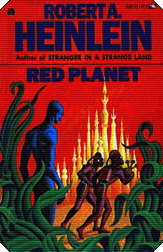 |
Willis is a Martian "roundhead," a small, round, furry creature that figures prominently in RAH's third juvenile, Red Planet. Willis has been adopted as a pet by teenager Jim Marlowe, one of the human residents at the southern colony of Charax. The peculiar capabilities of the Martian native, and its knowledge of Martian flora and fauna enable its "owner" to thwart a conspiracy intended to prevent the colonists from making their scheduled migration to Mars' equatorial region before the onset of the long winter months. What Jim does not realize is that Willis is actually an adolescent himself, in the midst of just one of the many stages of development of the dominant intelligent lifeform of Mars.
Jim and his best friend Frank Sutton travel to Syrtis Minor for advanced schooling, and Jim's parents allow him to take Willis along. During a stop-over in their journey, the boys encounter an adult Martian who escorts them into his home in the native city of Cynia, initiating them into his "nest" with a simple but sacred ceremony, that of sharing water. This particular ritual would later figure prominently in RAH's most famous novel, 1961's Stranger in a Strange Land. Once the boys have settled into the routine of school they are confronted with a Draconian list of rules and regulations imposed by the new headmaster. Two that distress Jim the most involve the confiscations of his beloved pet and his gun. RAH's casual depictions of the youths' use of sidearms was another issue which caused him much conflict with his editor. Willis is locked in a desk drawer in the headmaster's office where one of his most unique abilities comes into play. The Martian has not only been able to learn English, but also has the talent of being able to repeat exactly, and in the original speaker's own voice, anything overheard, which in this case is a discussion of the Company's intent to prohibit the southern colony's upcoming migration.
Willis is able to escape, and with the information they now have the boys run away from school to return home and inform their parents of the impending crisis. Many adventures and close calls later they are able, with the aid of their newly acquired "water brother," to successfully confront and defeat the Company's proposed policy of year-round habitation in the extreme weather conditions of the southern hemisphere. Red Planet is another example of RAH's depiction of planetary conditions which in no way reflect the realities of the Mars that we know, but this should not interfere with the reader's enjoyment of the novel. Later in his career RAH would introduce the concept of the "multiverse," alternate planes of existence wherein the differences from our reality can be very subtle and minor, or different to the extreme. With this in mind, all of RAH's work can be enjoyed for his abundant story-telling abilities without dwelling on those concepts we "know" to be untrue.
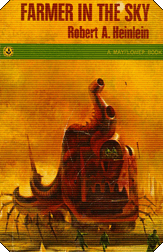 |
A purchase through our links may earn us a commission.
I could devote several pages to each of the remaining titles in this series, but in that case I would probably still be at it months from now. Even though I may return to this in the future and do just that, for now I will give a brief synopsis of the remaining nine titles, with a re-cap at the end to reflect on the importance of this series in not only RAH's career, but to the SF genre in general. I want to point out again that the majority of these titles can be enjoyed by readers of all ages, both long-time SF fans as well as neophytes. They are classified as the "juveniles" solely because that is the way they were originally marketed and their main protagonists are juveniles themselves. There are at least four of them that, while I would not list them in a Top 10, I do consider to be among the best of RAH's career, equal to the "adult" offerings of many others in the field.
Farmer in the Sky (full review HERE) was the 1950 entry in the series. Bill Lermer is an Eagle Scout and star student whose life is just getting back to normal following his mother's death. His father decides to emigrate to the Jupiter moon of Ganymede but wishes Bill to remain on Earth to finish his schooling. Bill is adamant in his desire to remain with his father and succeeds in being accepted for emigration himself. The rigors of the spaceflight to his new home, as well as the hardships encountered on the primitive outpost of Ganymede, are but two of the obstacles to Bill's acceptance of his new life. He also must adjust to the fact that his father has remarried - single men are not eligible for emigration. During the flight, Bill encounters other Scouts, and they form a new troop which continues its activities on Ganymede. This novel, in a condensed version and under the title "Satellite Scout," had been previously serialized in the Boy Scout publication, Boy's Life magazine. In 2001 it was awarded a Retro Hugo.
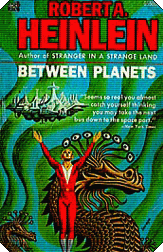 |
The title of 1951's Between Planets refers to the fact that its hero was born in a spaceship in transit between two planets. Don Harvey's father is a native of Earth but his mother was born on Venus, and at the beginning of the story Don is on Earth at a boarding school while his parents are on Mars at a scientific research facility. His unique situation makes for divided loyaties when the Venus colony revolts against the authority of the Federation of Planets. Don's parents have arranged passage for him to Mars but his ship is comandeered by the forces of the Venus Republic and he is forced to choose whether to return to Earth or go to Venus.
He chooses Venus since he spent his childhood there and hopes to find old friends who can help him in his efforts to get to Mars. It would be easy to devote much space to this book alone as it contains several sub-plots, changes of location and perspective, and the distinctively unique maturation process of its hero. This is one of the four I consider to be the best of the series. I will not provide any further spoilers however, other than to point out that the Venus environment again is unlike what we know to be true, and also that the depiction of the native creatures of that planet is different from the way RAH described them in Space Cadet or "Logic of Empire," so it is obvious this story cannot be considered part of the Future History. This novel was also serialized in a condensed version, this time in Blue Book, and with the title "Planets in Combat."
A purchase through our links may earn us a commission.
The Rolling Stones, published in 1952, introduced characters that would later be featured in other RAH works. Hazel Stone and her twin grandsons Castor and Pollux, along with the twins' parents, engineer Roger Stone and his doctor wife Edith, and their siblings Meade and Lowell, tour the solar system while at the same time transmitting back to Earth scripts for an on-going television serial, "The Scourge of the Spaceways." Beginning from their home on the Moon, the Stones travel to Mars, the asteroid belt, and finally outward to Titan, giant moon of Saturn. This novel is full of realistically believable scientific speculation about the possibilities of the exploration of our solar system, as well as touches of bright humor.
Fans of the Star Trek television universe might be able to detect a resemblance between the Martian flat cats in this novel and David Gerrold's "The Trouble with Tribbles." Gerrold says he was thinking of rabbits in Australia, while RAH credits the genesis of the idea with a turn-of-the-century short story, "Pigs is Pigs," by Ellis Parker Butler, proving that it doesn't matter where an idea comes from, any good writer, whether it is RAH, David Gerrold, or anyone else, can develop it into a meaningful story. This novel was published in the U. K. and other countries with the title Space Family Stone, and had been serialized in Boy's Life as "Tramp Space Ship."
"There were only three hundred years from Plymouth Rock to atomic power; there are still more outhouses than flush toilets in the United States...and the ratio will not have changed much on the day when men first walk the silent face of the Moon. The anomalies of the Power Age are more curious than its wonders."
Every time I read or think of 1953's Starman Jones, I can't help but recall this statement RAH made at the end of his preface to The Man Who Sold the Moon. Maximilian Jones lives on a small farm with his widowed mother in a rural setting which will remind anyone of my generation of scenes and characters out of Petticoat Junction or Green Acres. Max's mother remarries, to a man he despises, and after a heated argument over the fate of the family farm, Max runs away. His destination is Earthport, and along with his very meager posessions Max carries a treasured set of technical books left to him by his uncle Chet, a member of the prestigious Astrogators Guild.
It is his intention to petition for apprenticeship in the Guild and find a career in space, but his uncle had died before being able to nominate him for membership. The Guild denies him admittance and confiscates the books as well. A man Max encountered during his trip helps him to obtain counterfeit credentials and he is able to sign aboard the starship Asgard as a member of the Guild of Space Stewards, Cooks, and Purser's Clerks. Max's relationship to his uncle is brought to the attention of the Chief Astrogator and he is invited to field test for a position with that guild. Like Andy Libby from "Misfit" and Methuselah's Children, Max has an eidetic memory, a talent he must put to use when the ship is lost in uncharted space and following the deaths of the Captain and the Chief Astrogator. They land on a nearby planet, but the perils they encounter make it necessary for them to attempt a return to known space. With the star charts and mathematical tables from his uncle's books fresh in his mind, Max is successful in getting the ship back on its course, and he ends his first space journey as the Captain of the Asgard.
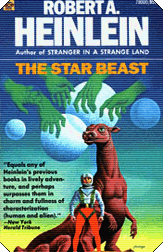 |
A purchase through our links may earn us a commission.
There are many aspects of 1954's The Star Beast that amazingly were allowed by the editors. One of the teenage characters has divorced her parents and many figures of authority, from local police and judiciary up to federal military and diplomatic positions, are depicted in a distinctly negative light. John Thomas Stuart XI is the latest in a long line of Stuarts whose prized pet is Lummox, a creature brought back to Earth from a distant planet (I can't recall which of the John Thomases was the responsible party). For many years Lummox is a lovable, intelligent pet, then when he develops a taste for metallic objects he begins to grow in rapid spurts.
At the opening of the novel he is the size of a tank and somewhat resembles a dinosaur. A set of unfortunate incidents causes the authorities to decide Lummox is a menace to the safety of the community and attempts are made to capture or kill the beast. John Thomas and his best friend Betty escape with Lummox and hide out in the mountainous region west of the city. They are eventually captured and put on trial. Since Lummox is an extraterrestrial creature, their case comes to the attention of Henry Gladstone Kiku, the Permanent Under-Secretary for Spatial Affairs, in my opinion one of the best characters RAH ever created. It turns out that Lummox is actually a long-lost member of the royal family on his home planet, and Kiku's negotiations result in John Thomas being accepted as an ambassador from Earth as he accompanies Lummox on his triumphant return. Portions of this novel were published in the Magazine of Fantasy and Science Fiction as "Star Lummox."
After further consideration I think I need to change my assessment of several of the juveniles and increase the number of them that I consider to be great books. Some I have not read for several years, but the memories of them are still vivid in my mind. The Star Beast is a perfect example of RAH's refusal to talk down to a younger audience. It is populated with several well-deliniated and believable characters, and even though Lummox at first seems to be just an element of comic relief, his situation lends itself to some very serious considerations of the possible consequences of our actions if we ever do encounter other civilizations in space. Discounting a few highly improbable occurrences, Starman Jones is one of the most entertaining reads in the RAH canon, one that does not shirk from the idea that not all our extraterrestrial adventures are destined to be pleasant ones.
A purchase through our links may earn us a commission.
Even though 1955's Tunnel in the Sky could be accused of being a rewrite of William Golding's Lord of the Flies (published the previous year), I still think it is one of the best of RAH's juveniles and head-and-shoulders above many other works considered to be classics of the field. The technological innovation of trans-spatial "gates," while highly improbable based on any current knowledge, provides the perfect gimmick for the unfolding of the plot. Rod Walker is a senior in high school, taking classes in New York, but living in one of its suburbs, located on the Grand Canyon plateau. Utilizing several gate transfers, Rod is able to get home in about twenty minutes.
Another such gate - The Templeton Gate - takes Rod and several of his classmates to a remote area where they are to undergo a survival test. They have no idea if they are still on Earth or another planet, and it is several days before the skies clear enough for them to tell by the stars. Eventually they realize they are not on Earth, and also that something has gone terribly wrong. The anticipated recall signaling the end of the test does not come as expected, and the youths must face the fact they may be stranded forever. No more spoilers here. Read the book; I guarantee you will be both entertained and enlightened. Just watch out for the "stobor."
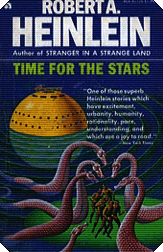 |
Time for the Stars, from 1956, postulates the possibilities of telepathic communication between individuals of close relationship, including the main characters who are twins. It has been established that such communication is virtually instantaneous, not limited by speed-of-light, and thus potentially a link between Earth and its growing fleet of interstellar ships. One set of a pair remains on Earth, growing old normally, while the other experiences the wonders of exploring unknown worlds, aging more slowly due to the paradoxes of Einstein's Relativity Theory.
A purchase through our links may earn us a commission.
Citizen of the Galaxy is another example of RAH utilizing a classic narrative tradition and shaping it into something uniquely his own. The tale begins at a slave auction on the distant planet of Jubbul. Thorby is of indeterminate age and ancestry and his presence on the auction block brings only howls of derision from the usual buyers. The only one who offers a bid is Baslim, a one-eyed, one-legged beggar. His intention is to succor the boy and protect him until he is able to fend for himself, then he will be freed. There is nothing more despised in Baslim's mind than the institution of slavery.
Baslim is more than he appears to be, as Thorby slowly realizes. The beggar uses sophisticated techniques to educate Thorby on many subjects, at the same time teaching him the art of begging. Baslim is apparently some sort of spy, but for whom Thorby is unable to determine. Following Baslim's arrest, Thorby is rescued by the captain of a trading starship who apparently owes a debt to Baslim. Again, I will not reveal any more of the plot. I consider this to be the best of the juveniles. A recent online poll conducted by Random House's Modern Library, including over 400,000 votes, listed this novel among the Best 100 Novels (not just SF) of the 20th Century. It was the only one of the juveniles so honored, but six other RAH titles made the list as well.
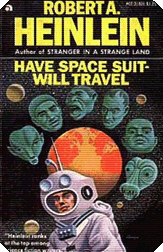 |
The final book in the series, 1958's Have Space Suit - Will Travel, is also one of the most popular. Kip Russell wins a used spacesuit in a jingle contest, and he devotes many hours to refurbishing it into a working suit, including radio capabilities. One day as he is testing the suit in the fields behind his home he picks up a distress signal over his radio. Moments later a ship lands nearby and Kip is plunged into the adventure of a lifetime. The pilot of the ship is an extraterrestrial attempting escape from another dominant species. Kip comes to its aid and his journey takes him to the Moon, Pluto, and finally a planet circling the far star of Vega. There he must defend the value of the human race in a courtroom of the collected intelligent species of the galaxy.
A purchase through our links may earn us a commission.
Beyond the Juveniles:
In October & November 1959, the Magazine of Fantasy & Science Fiction ran a serialized version of "Starship Soldier." RAH submitted the full version as the thirteenth novel in the juvenile series. Alice Dalgliesh was still his editor at Scribner's and she rejected the novel, retitled Starship Troopers [Full review HERE], based on what she considered to be excessive violence as well as the political stance expressed by the author. RAH refused to edit the book, and instead had his agent shop it around to other publishers. When it was accepted by G. P. Putnam's Sons it signaled the end of RAH's association with Scribner's. It also turned out to be one of his most popular books, and in my opinion far superior to the Paul Verhoeven film version produced in 1997, which I cannot recommend. However, if you get the opportunity, you should check out Roughnecks: The Starship Trooper Chronicles, a CGI-animated production from 1999.
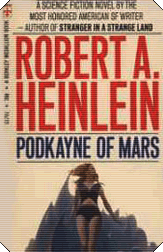 |
In 1963, Podkayne of Mars was published. It was quite possibly written with the intention of its being part of the juvenile series as well, but since it was printed by Putnam and not Scribner's, and five years had passed since Have Spacesuit - Will Travel, I do not consider it to be one of the "official" juveniles. It also happens to be RAH's first novel written from the first-person perspective of a female character, all of the juveniles' main protagonists having been male.
A purchase through our links may earn us a commission.
The first Heinlein novel I read, in fact the first adult SF I read, was Stranger in a Strange Land (now reviewed). I'm aware that was not the best place to start, but I can't change that now. I can't recall which of the juveniles was the first I encountered, but being new to SF at the time I was not aware of their classification as "juveniles." I saw them as just further evidence that RAH was a brilliant and innovative writer, and with the exception of Rocket Ship Galileo, and to a lesser extent Space Cadet, I think they are immensely enjoyable and thought-provoking works. Heinlein is perhaps best known for these titles among his devoted fans, even though SiaSL is his best-known book by the general reading population. There are many who consider the course his career took following SiaSL to be a detrimental one, at least in the sense that he is accused of losing touch with his narrative craft at the expense of philosophical ramblings. Personally, I think he did his best work in his later years, but this does not in any way lessen the importance and significance of his earlier work, including the juveniles.
The most significant impact the juveniles had on the field is that of capturing the imagination of countless teens and adolescents, inspiring many of them to pursue careers in the sciences. Many current NASA employees have credited RAH and other SF writers as the main impetus in their choice of careers. Following his death in 1988, RAH was posthumously awarded the Medal for Distinguished Public Service by NASA, and during the ceremonies in his honor many of the participants expressed such sentiments. Other SF writers also have credited RAH as almost single-handedly creating what is perceived to be modern SF. Heinlein himself had expressed his feelings of anxiousness about the course the U.S. and the world was taking, and his efforts were purposefully intended to inspire others to want to go to space, in fact he felt it was possibly the only hope for mankind to survive the future.
Not that it really matters here, but I am going to close this essay with a list of the juveniles in the descending order of my preference. Anyone else would probably list them in a different order, but for those who have not read any of them this would be the order I would recommend. I think it would be a shame if Rocket Ship Galileo was the first anyone read, as that might cause them to think the rest would not be worth the effort. Start with the best then work your way down until you think the quality isn't there anymore.
A purchase through our links may earn us a commission.
1. Citizen of the Galaxy
2. Tunnel in the Sky
5. Have Space Suit - Will Travel
4. Between Planets
3. Red Planet
6. The Star Beast
7. Starman Jones
8. The Rolling Stones
9. Time for the Stars
10. Farmer in the Sky
11. Space Cadet
12. Rocket Ship Galileo
For anyone that thinks starting with the best is not the way to go, I recommend you skip Rocket Ship altogether and read the others in the order they were published. That way you could track RAH's development incrementally. Even my ranking of the books could change in the future after reading them again - and I will be reading them again you can be sure. I even re-read Rocket Ship Galileo a few years ago, just to see if my opinion of it might change. It didn't.
Related Links:
The Heinlein Society Website
The Robert A. Heinlein Homepage - maintained by James Gifford
We would appreciate your support for this site with your purchases from
Amazon.com and ReAnimusPress.